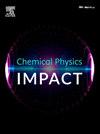工程两亲性金硫酸酯簇增强发光和控制组装
IF 4.3
Q2 CHEMISTRY, PHYSICAL
引用次数: 0
摘要
两亲性金硫酸盐簇由于其多用途的结构和光学特性而引起了人们的极大兴趣,这使得它们在纳米技术和生物光子学方面的应用具有价值。本研究概述了一种多步骤合成au - c11h23 - peg17金硫酸盐纳米颗粒的系统方法。通过PEG修饰、巯基引入和二硫还原反应合成了巯基配体HS-C11-PEG17,并通过¹H NMR和元素分析对其结构进行了证实。金硫酸盐团簇的形成涉及到AuCl4·4H2O与HS-C11-PEG17的反应,随后通过DLS(动态光散射)纯化得到分子尺寸为10 nm的纳米颗粒。SAXS(小角x射线散射)和HPLC(高效液相色谱)分析揭示了纳米颗粒生长和反应过程的时间依赖性,而质谱分析鉴定了环状和开放四聚体簇。AFM成像突出溶剂和浓度依赖的组装形态,从多层到针状结构。光物理研究表明,24 h内的发射强度增加了800倍,发射强度受烷基链长度和PEG链性质的影响。这些发现强调了两亲性配体在团簇组装、亲金相互作用和光学性质中的作用,展示了AuS-C11-PEG17团簇在先进纳米技术应用中的潜力。本文章由计算机程序翻译,如有差异,请以英文原文为准。

Engineering amphiphilic gold thiolate clusters for enhanced luminescence and controlled assembly
Amphiphilic gold thiolate clusters have garnered significant interest due to their versatile structural and optical properties, making them valuable for applications in nanotechnology and biophotonics. This study outlines a systematic approach to synthesizing AuS-C11H23-PEG17 gold thiolate nanoparticles through a multi-step process. The thiol ligand, HS-C11-PEG17, is synthesized via reactions involving PEG modification, thiol introduction, and disulfide reduction, with structural confirmation through ¹H NMR and elemental analysis. The subsequent formation of gold thiolate clusters involves reacting AuCl4·4H2O with HS-C11-PEG17, followed by purification to yield nanoparticles with a molecular size of 10 nm as measured by DLS (Dynamic Light Scattering). SAXS (Small Angle X-ray Scattering), and HPLC (High-Performance Liquid Chromatography) analyses reveal time-dependent nanoparticle growth and reaction progress, while mass spectrometry identifies cyclic and open tetramer cluster species. AFM imaging highlights solvent- and concentration-dependent assembly morphologies, ranging from multilayers to needle-like structures. Photophysical studies demonstrate an 800-fold increase in emission intensity within 24 h, with emission influenced by alkyl chain length and PEG chain properties. These findings underline the amphiphilic ligand's role in cluster assembly, aurophilic interactions, and optical properties, showcasing the potential of AuS-C11-PEG17 clusters in advanced nanotechnological applications.
求助全文
通过发布文献求助,成功后即可免费获取论文全文。
去求助
来源期刊

Chemical Physics Impact
Materials Science-Materials Science (miscellaneous)
CiteScore
2.60
自引率
0.00%
发文量
65
审稿时长
46 days
 求助内容:
求助内容: 应助结果提醒方式:
应助结果提醒方式:


